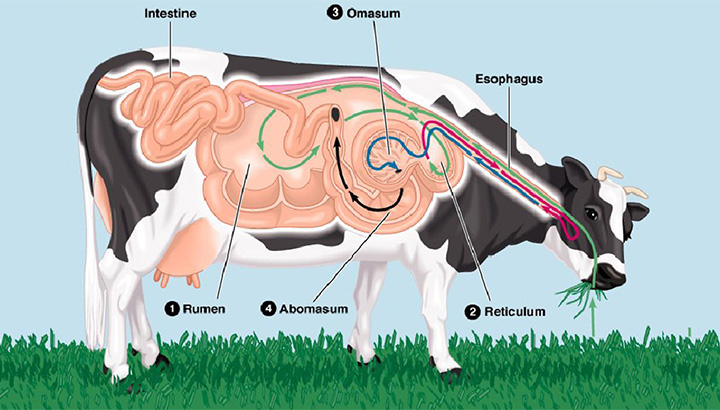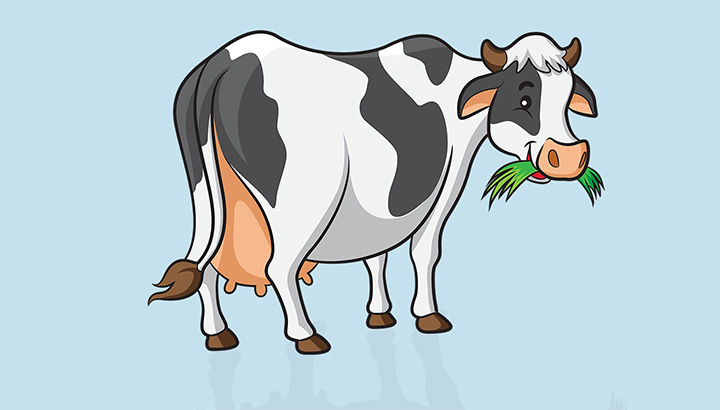It’s a common belief that cow breeds play a major role in milk quality and production. However, the truth is that it’s not the breed of cow that determines the quality of milk they produce, but rather what they eat.
On the production side, the breed may have effects as genetics are involved in this criteria, but again, feed is more important.
Our principal is that feeding the breed is more important than the breed itself. Cows are able to convert the food they eat into milk, so the quality and quantity of milk produced is directly related to the diet.
This means that if you want to produce more milk, or higher quality milk, you need to focus on feeding the cows rather than their breed.
Of course, there are some breeds of cows that are better at producing milk than others. However, the food they eat will ultimately determine how much milk they produce.
Also, the breeds that eat more and produce less milk will give the nutrients in concentrated amounts. Also, the cows that are at the last part of their lactation will give concentrated nutrients.
Still, the logic is that even if you give a high nutrient value to feed a high producing cow, the nutrient value will be much higher. In the Hindi language, we call this “sampurna aahar.”
We concentrate on feeding the cows; a good breed obviously produces more milk, but feeding the cow is more important than focusing solely on the breed. It is the most effective method of ensuring high quality and quantity milk production.
We want your attention to why we believe “It’s fed to milk, not bred to milk”
Well, it all starts with the nourishment of the calves to adopt all the genetics of their father and mother cow. Now, apart from this, here you will…
Learn about the digestive system (process) of a cow
You’ve probably seen a cow or a buffalo eating grass. These animals swallow grass without chewing it. After a good amount of grass has been swallowed, it goes into their stomach, called the Rumen, and when they sit during a time of rest, they bring the food from the Rumen to the mouth and chew it leisurely.
The food is completely chewed and mixed with saliva during this process, which is known as rumination (jugaali in Hindi), and these animals are known as ruminants.
Let us explore the cow’s digestive system. A Cow’s stomach is a complex organ with four chambers: the rumen, reticulum, omasum, and abomasum.
Food Route
Food-Mouth-rumen-mouth-chewing-rumen-reticulum-omasum- abomasum-intestine-colon

Structure of Digestive system and digestion in ruminants
The rumen is the largest stomach chamber and it is here that a high number of bacteria create cellulase, which aids digestion.
Food that is swallowed enters the rumen, where it is partially digested into a paste known as cud. The partially digested food is then transported back to the mouth, mixed with a large amount of saliva, and thoroughly chewed.
This would then enter the rumen and be digested for some time; cellular and other enzymes would act on the cellulose here. The meal is now moved to the second chamber, where bacteria-produced reticulum enzymes continue to breakdown it; the food is nearly digested here.
The fully digested food, along with bacteria, now enters the omasum, the third chamber. Internally, the omasum is folded into several folds to increase the absorptive area. The water and bicarbonate present in the food are absorbed in this chamber.
The food is now concentrated and directed to the fourth chamber, the abomasum. This chamber is considered the true stomach because the glands in the abomasum secrete acid, which kills bacteria and denatures proteins, tearing down their structures.
The enzymes secreted in this chamber digest the proteins. In the intestines, the food containing the products of digestion enters. All the nutrients are absorbed in the intestine.
So now you know why cattle chew food all the time!
How does calf (heifer) nutrition make such a big difference in milking
One of the first sets of cows we bought was one of the main performers, giving us 10000+ litres of milk in 10 months.
From the mother cow who gives birth to a calf, that calf was raised from scratch by us from day one. Other than the mother’s milk, all the nutrition was taken care of by us.
When that calf became a heifer and became pregnant for the first time and started giving milk, it gave 30% more milk than the mother.
So, regardless of the breed of cow, the feed and management make a significant difference in how much milk we can obtain from it and the quality of milk we can get from it, so we must ensure that we feed them properly and with “rich, nutritious feed.”
Let us proceed and read about what we feed our cows in order for them to be healthy and produce high-quality, rich milk.
Types of cattle feed
1. Corn Silage (Fermented + mixed oil)
Corn silage is a high-energy grain that is commonly used in cattle feed. It is a good source of carbohydrates and fat, which can help fulfil the cow’s nutrition requirements and, as a byproduct, increase milk production.
2. Soybean meal
Soybean meal is an excellent animal feed because it is delicious, easily digestible and high in digestible energy. It is a very good source of protein. Soybeans are generally solvent extracted and contain between 16 and 21% oil. The leftover meal includes around 1% oil.
Soybean is a high-protein legume that is commonly used in cow feed. It is a good supply of balanced amino acids, which are essential for milk production.
3. Cottonseed
Cottonseed is a source of crude fat and protein that is often used in cattle feed. It is a good source of fat, which is essential for cow health.
4. Molasses based feeds(Mixed with Shatavari)
Molasses is a by-product of sugar production and is used as a sugar source in many cattle feeds as sugar is nothing but energy. It is mixed with other ingredients like Shatavari. This type of feed is high in energy and helps improve cow health.
Note: It should be used with care as it can lead to health problems like bloat if not fed properly.
5. Dry fodder
Dry fodder is plants that have been dried. It is mixed with other ingredients to make dry cattle feed. This type of feed is high in fibre and helps improve cow ruminations and health.
6. Green fodder
Green fodder is fresh, green plants and grass that are fed to cattle. It can be either grass or legumes. Green fodder is a good source of nutrients and helps improve milk production.
I. Rachka
It provides a rich source of protein and water in the feed. It has a high content of moisture in it. Cows love it.
II. Napier
Napier is a type of grass that is common in tropical regions. It is used to make a cattle feed called Napier grass fodder. This type of feed is high in fibre and protein and helps keep the cow’s digestive system working well.
7. Mineral mixture(Supplement)
The mineral mixture is a type of supplement that is added to cattle feed to provide additional nutrients. It is typically made from a combination of minerals, vitamins, and trace minerals.
It is compulsory to supplement cow feed as land value has degraded a lot because of the usage of chemicals in farming processes. As a result, grains and grasses are no longer as nutritious as they once were. mineral mixtures add to the health of the cow.
This is one of the most common types of feed given to dairy cows. All of these feeds are mixed together and given to the cow. This is called TMR (total mixed ration). This feed contains a lot of energy, protein, fibre, and macro- and micronutrients.
It helps in improving the health of the cows and if a cow is healthy and happy; in return, it gives us more and more nutritious milk. Thus, the quality of milk becomes very rich. Again, more production from cows is a side effect.
Nota bene: stocks are stored in such a way that the quality is preserved and aflatoxins are avoided. are carcinogenic and can cause cancer. Whatever the cow eats will end up in her milk in some form or another.
There are many different types of cattle feed available, and the type that you choose will depend on your goals and objectives. If you just want to produce milk to give it to some company at a very low price, you can even do so because it will have low protein and just fat as farmers are paid on a fat basis in this case.
If you want highly nutritious milk, you can even do so. So the price of milk may vary and the quality of milk may vary too. It’s important to choose a feed that is right for your objective.
Why do we claim our milk is rich in nutrients?
We are a farm-to-table distribution company that specialises in 100 percent raw milk from cows that have not been treated with hormones or antibiotics. Our goal is to provide you with pure, absolutely fresh and very nutritious milk naturally so that we can add a bit to your health and immunity.
This also proves why our ancestors kept milk as a prominent part of our meals. Our cow’s milk is rich with calcium, protein and more than 17 micronutrients. We ship all of our deliveries on time early in the morning, so even your kids can have fresh milk before going to school.
Here are some fun facts about milk and cows:

- Milk production is stimulated by the hormone prolactin, which is released into a cow’s bloodstream when she gives birth.
- The cow’s biological clock is strong. Cows are very compliant animals and they know when it is time to be milked and when the feed should be dispensed.
- A cow’s udder can hold about 25–35 pounds of milk at a time.
- The fore udder of a cow holds 45% of the milk, whereas the rear udder holds 55%.
- Bathe your cow before milking will deworm her so that it will make them feel relaxed, resulting in more milk.
- It takes a lot of blood, water, and energy to produce milk. A cow can consume up to 50 gallons of water per day.
- The cows have exactly the same social hierarchy as we do. They have a queen, ministers and followers.
- Cows are typically milked twice and also thrice a day.
- Milk is composed of water, fat, protein, lactose, minerals, and vitamins.
- The fat content of milk varies depending on the breed and feed of the cow, but it typically ranges from 3–5%.
- Milk is a good source of calcium, protein, phosphorus, and vitamin D.
This is one of the most common types of feed given to dairy cows. All of these feeds are mixed together and given to the cow. This is called TMR (total mixed ration). This feed contains a lot of energy, protein, fibre and micronutrients.
It helps in improving the health of the cows and if a cow is healthy and happy, in return it gives us more and more nutritious milk. Thus, the quality of milk becomes very rich. Again, more production from cows is a side effect.
Nota bene: stocks are stored in such a way that the quality is preserved and aflatoxins are avoided. are carcinogenic and can cause cancer. Whatever the cow eats will end up in her milk in some form or another.
There are many different types of cattle feed available, and the type that you choose will depend on your goals and objectives. If you just want to produce milk to give it to some company at a very low price, you can even do so because it will have low protein and just fat as farmers are paid on a fat basis in this case.
If you want highly nutritious milk, you can even do so. So the price of milk may vary and the quality of milk may vary too. It’s important to choose a feed that is right for your objective.
We built a comfortable area on our farm to provide your cows with a comfortable sitting surface made of biodegradable composite and continue to cultivate it so the cow’s hoof can dip in it, which saves them from injuries because a happy and healthy cow produces high-quality milk.
Milk is a nutritious and delicious food that can be enjoyed by people of all ages. It is a good source of protein, calcium, and more than 17 micronutrients. Milk can be produced by cows, goats, sheep, and buffalo. The type of feed that you choose will determine the nutrient content of your milk.
If you’re looking to produce milk with a higher nutritious content, then you will need to choose a feed that is high in Fat, Protein, Fibre and Supplements. Whatever your goals, it’s important to choose a feed that is right for your cattle.
Feeding for quantity and quality milk can make a big difference if you understand the composition of what you’re feeding your cattle.

